Another Timbre TimHarrisonbre
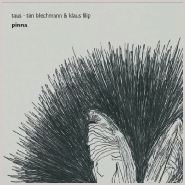
at49 Pinna
By Taus
Tim Blechmann laptop
Klaus Filip laptop
One track 51:00
Recorded live in Vienna, July 2010
NB contains very low frequencies, best heard through a good audio system, not laptop speakers
Interview with Tim Blechmann
Why 'Taus'? What does it mean?
Klaus and me first played together at the fund-raising
concert for the klingt.org webserver. Dieb13 (who runs klingt.org) asked for a name
and suggested `Taus' as a combination of Tim and Klaus. A similar name was used by the
duo of his girlfriend Billy Roisz with Silvia Fässler, who performed as `Silly' before
renaming to `Skylla', and Dieb13 and Billy sometimes use the name `Dilly'.
Pinna sounds very different from your earlier duo on L'Innomable. Can you describe
what you see as the differences between the two discs?
Our first release `The Organ
of Corti' was a digital studio recording. We spent a few days at Kleylehof, Klaus's
atelier/farmhouse on the border between Austria and Hungary, playing and recording
every night. The sound is very clean, because everything is digitally generated and
recorded.
`Pinna' was a recording of a concert that we played in a small church in Vienna.
It is a microphone recording of a ‘real’ sonic space: we used 5 or 6 speakers distributed
in the space, e.g. one speaker was laying on the gallery facing the ceiling. The
microphones captured the sound from the speakers, the reverberation of the space
... and all kinds of environment sounds like birds, audience movements, people passing
by, etc, which cannot be separated from the music.
Yes, I really like the fact that you hear the space in Pinna; it seems to me that
any improvisation is specific to the context in which it was played, and it's often
good to hear something of this in a recording. But could you tell us more about
the instrumentation for this church concert? What
exactly were you both playing?
Klaus
and I were using computer. Klaus uses only sine waves, while I am playing noise textures
and crackle sounds. These sounds are very easy to distinguish, because they don’t
mask each other. We always hear precisely what the other musician is playing, so
we can react very directly to the situation. However, the computer itself doesn't
produce any sound, so we need loudspeakers to transform the electrical signal into
vibrations. When playing a concert, it’s always a question, which speakers?, how
many?, and where to place them? For Klaus's sine waves, it doesn’t really matter
where you place the speakers, but he always likes to have a subwoofer to be able
to play very low-frequency sounds. But for my noise textures, the placement of the
speakers matters a lot because they are very easily locatable, and I try to play different
sounds on different speakers.
Musically the piece is mostly very quiet, and yet the sound seems really full and
rich. I suppose that comes from the spatial aspect. Was it evident to you at the
time that the set you were playing was very strong, or did you only think it was
worth releasing on disc once you’d heard the recording?
It was probably one of our
most relaxed concerts. As it was a rather hot weekend in July, not so many people
came to listen to the concert and therefore the situation was very concentrated.
Bob Ostertag once wrote that John Zorn refused to play for too many people because
it ruined the music. He has a good point there, as it is much more inspiring to play
for an attentive audience. Playing with Klaus in such a situation is almost a form
of meditation.
We actually didn’t think of a recording, but Thomas Grill, one of the organisers, brought a mobile recorder. When I heard the recording, I was pretty surprised that it really captured the atmosphere of the concert. There were actually some rather loud parts towards the end of the concert: in fact I had to reduce the volume of the final part for the CD to avoid listeners having to adjust the volume themselves when the quiet part is too quiet or the loud part is too loud.
You say that playing with Klaus is almost a form of meditation, and that really hit home today when I was trying to select a short extract from the piece to use as a taster on the label website. It was really hard, because the pace at which the music moves is glacial. It’s like waiting for New Zealand to bump into Chile. This isn’t so evident when you’re in the flow listening to the whole piece, but picking out a 2 or 3 minute extract feels meaningless; it tells you next to nothing about the music in its totality.
To quote Morton Feldman: "All we composers really have to work with is time and sound - and sometimes I'm not even sure about sound". I suppose this applies to almost any music. When the music is performed, it is always in a context: a specific event does not come on its own, but it is preceded and followed by other music. When taking a small sniplet, this context gets lost.
Could you say a little about the improvised music scene in Vienna? You’ve mentioned Dieb13 and Billy Roisz, as well as Thomas Grill – and Katharina Klement and Angelica Castello are credited on the sleeve – all musicians who I rate very highly. There seem to be a lot of active and interesting players. Do you think there are any distinctive features about the scene in Vienna?
There are quite a few interesting musicians in Vienna, although I am not sure if they consider themselves mainly as `improvising' musicians. However one common aspect of many Viennese musicians is the use of electronics. One reason might be the electronic music course, `Elak', that many Viennese musicians attended in one way or another, and where Austrian computer music legend Günther Rabl taught for many years. It’s also where Thomas and Katharina are currently lecturing. At the moment all my regular collaborators from Vienna use electronics: Klaus is using a laptop, Manuel Knapp plays analogue feedback devices, and Conny Zenk uses a computer to do video projections.
Could you tell us how you earn your living? Is it possible to make money from musical activities in Austria?
I am definitely not able to make my living from music. And I know only very few musicians who can make their living from their own music. I mainly earned money from developing software. Some of my projects are somehow related to music, although it doesn't happen very often that they are related to my own music. Currently I am looking for a way to do a PhD somewhere in the field between computer sciences and computer music.
In general I suppose it is really hard to make one’s living from music, unless the music is suitable for the mass, institutionalised or you are extremely lucky.
Yes, it’s the same in the UK, but I suspect there’s even less state support for this kind of music here. But then people like Seymour Wright argue that in some ways it’s better if your music is totally separate from the business of earning your living, because that way commercial factors don’t affect your aesthetic choices at all.
One can probably distinguish between making a living from arts, making a living from something related and doing something completely different. However it is double-edged: if you try to survive with arts it is possible that you adapt it. Or even worse: you could change the focus from developing
your work to promoting it. But on the other hand you have much more time to focus on your own works, if you don't have a day job. When doing something related to arts, you at least use the same tools/techniques and it is not
completely detached.
Personally, I like to have the distinction between my work/research which is more of an intellectual challenge for the brain, and my music/art that is for the heart to make life worth living.
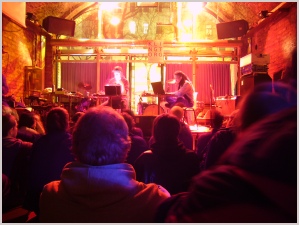
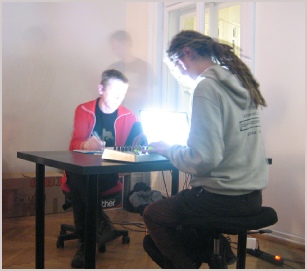
Taus
In the church at St Ruprecht
Reviews
“I have been admirer of the work of Tim Blechmann, the German (but long time resident of Vienna) laptop improviser and very much enjoyed the CD he released a few years back on the L’innomable label as one half of the duo Taus alongside Klaus Filip, also from Vienna, and also a laptop improviser. I was then, exceptionally pleased to hear that the duo were to release their second album on the Another Timbre label. Pinna is that album, a fifty minute long unedited live set recorded in July 2010. Both of these musicians have always impressed me for their singular, very focussed vision for their music. Both work with a very minimal palette, Blechmann usually with a finely tuned array of muted grey fields of fuzzy white noise, Filip most commonly with sinetones. They both also are completely comfortable with the technology they use and their music is rooted entirely in the discourse of the laptop as instrument. They make no attempt to mimic other instruments or to throw firework displays of technological possibility. For me both of these musicians utilise a methodology in their playing as simple as someone like Radu Malfatti (with whom Filip regularly plays) or Sean Meehan. They make powerful music with very simple gestures.
From the outset of Pinna another key element to the work of these two is apparent, the presence and feel of the room in which they perform. I had never managed to see Blechmann play live, though have seen Filip a few times, but both musicians I think it is fair to say seem to feed off of the tone of the room around them. Their music seems to grow out of the hum of air conditioning, the murmur of an audience trying to be quiet, the city outside of the recording space, the murky, featureless detritus that we leave behind as a human race. The first hiss of Blechmann, the first honeyed swell of Filip rise out that familiar sound of a hushed concert space, the early sounds they make, at very low volume and almost inseparable from the sounds of the room. The duo’s sound grows into a dense swell, as happens often throughout the album, but somehow dissipates in ways that seem almost imperceptible. One minute we are hearing a deep grey rumble and a rich tone, the next both have slipped to vitally nothing, or Blechmann has moved to small, nearly inaudible prickly sounds and Filip’s glassy tones may had become transparent. The music is constantly shifting, glacially slow, to the point that when things disappear you don’t notice, and often only when there are sudden dilations of the sound as one or the other musician might expand their contribution. Brilliantly, in an interview with Tim Blechmann for the Another Timbre website, Simon Reynell describes the pace of the music as “like waiting for New Zealand to bump into Chile”. Despite the way the music seems to become a natural, if very gradual flow out of the environment the interplay between the two is still apparent, and there is a tension to the way the two sounds come together, often mushrooming together into deathly slow motion drama. Listening closely to the music, the interconnections between the two musicians, as I have quite often over the past week or so is greatly rewarding, you can get lost in the clouds of grainy tone or you can follow their threads through each other and hear them as two conversing voices.
Pinna is great. It appeals so closely to my own personal preferences in music, a lightness of touch, a sense of restraint rather than busyness, the strands of musical conversation left open on the surface and yet all done with an understated humility. The inside sleeve of what is maybe the nicest example of Another Timbre packaging yet also sums it up, a dense mass of scribbled lines, at first seemingly chaotic, but at closer inspection neatly distributed and containing some sense of order, albeit perhaps only a perceived one. Lovely, lovely music then.”
Richard Pinnell, The Watchful Ear
“Pinna is the outer part of the ear, by the way; fine title. And a fine recording. But fine in a way that always causes me to be at pains to quantify. Two laptops, a live 50+ minute performance of the general type that I think of as "steady state" rather than drone, though don't ask me to differentiate. It does take the shape of a crescendo though it's long enough in coming that the dramatic effect is felt before consciously perceived. Although on the one hand there's an evenness here, a "smooth" shifting of planes, a continuity of action, I sense grain everywhere. It may be fine-grained (!) to the point of sublimation but it's there.
It idles beguilingly for a good bit at the start, several layers biding their time, gathering energy; it's very much like standing near an extremely subtle motor, gradually realizing how much stuff is happening, how well integrated it is to fool you into thinking, for a moment, that it's one thing. It gestates for a good while, circling, softly rumbling, high, sine-like tones coasting atop, splitting apart, isolated bangs heard in the distance. Those keening tones almost take on a melodic aspect at points, quite beautiful. Second gear doesn't kick in until some 4/5 pf the way through but it's timing feels just right. Gentle, sonar-like blips manifest, the whole thickens and grows woolly. The crest is mild, not overblown, the subsidence relatively quick.
In sum, just a very, very satisfying experience and a seriously enjoyable hunk of music.”
Brian Olewnick, Just outside
“For someone with so restricted an improvising vocabulary – sinewaves and almost nothing else – Klaus Filip has built quite an impressive discography. The clue lies in its relative slenderness, evidence of his prudent choices in playing partners and contexts: lustrous drones for Los Glissandos quintet with clarinettist Kai Fagaschinski; disciplined, tonally rich exchanges with Toshimaru Nakamura on Aluk; and rigorous harmonic research conducted in the company of Radu Malfatti on Imaoto.
Those duos locate and calibrate often minute gradations of movement, texture and contrast within narrowly defined parameters. Not coincidentally, this is also the strength of Pinna, a 50 minute duo with laptopper Tim Blechmann recorded in a Viennese church in 2010. Blechmann is the more active of the two, counterpointing Filip’s wafer-thin tones with striated, fizzing frequencies and gritty bass rumble. His contributions give the album a relatively expansive sweep, as well as an undulating, linear momentum, with clusters of louder, busier passages linked by passages of elongated static that seem to arc and slide at the same time. True to type, they build to a sustained, noisy climax in the last ten minutes. The performance recording is lightly pockmarked with audience noise in the form of sundry bangings and clatter. They helpfully complement its digital textures, imbuing them with a sense of dimension while grounding them in a physical space.”
Nick Cain, The Wire
“Pinna also runs the gamut, from near silence to staggering volume, although its soundworld is quite different. This is a live recording of a concert given at a church in Vienna, and, unlike The Organ of Corti, Tim Blechmann and Klaus Filip's 2007 disc on L'innomable, the space is integral to the duo's sound, and the first-rate recording ensures we're immersed in it. Blechmann and Filip's fairly limited sound palettes combine astonishingly well, as single sounds coalesce and arch to a dull roar, all sense of environment subsumed in an a powerful, almost glacial wave. All areas of the pitch spectrum are explored, and good loudspeakers (or decent headphones) are especially important to appreciate fully this beautiful and powerful music. In its rawness at climactic moments, Pinna is different from anything either has done before. Don't expect, for example, the sparser textures and subdued shifting plains of Filip's imaoto with Radu Malfatti from two years ago. Nor does it rival his noisier excursions with Manuel Knapp, but fills the soundstage in the same way, punctuated by soft but sinewy tone clusters reminiscent of Cage's number pieces.”
Marc Medwin, Paris Transatlantic
“Sous le nom de Taus (Tim & Klaus contractés), Blechmann et Filip marient – en concert donné en 2010 en l’église St Ruprecht de Vienne – des éléments d’un langage qu’ils ont en commun (ces crescendos / decrescendos requérant patience que Filip envisagea avec Radu Malfatti sur Building Excess et Imaoto, ces respirations mêlées à des références à la nature que Blechmann pensa par exemple avec Seijiro Murayama sur 347).
Cet ouvrage de laptops, qui tient du recueillement tant il est concentré, célèbre avant tout la malléabilité des sons dont est capable l’instrument : les basses agissent au sol, les larsens annoncent l’apparition d’aigus moins irritants dont les interférences scinderont les pistes d’évolution afin de créer des voies secondaires qui, à force de retours et de trajectoires fluctuantes, pourront se recouper. Pour que l’exercice ne soit pas sans fin, Blechmann et Filip peuvent interrompent quelques-uns de ces chants réverbérés : le silence reprend alors sa place, le duo laissant le champ libre à la rumeur d’une église dont il a transformé le décorum ou aux piaillements d’oiseaux qui ne font que passer au large de leurs paysages magnétiques.”
Guillaume Belhomme, Le Son du Grisli
“Taus est le nom du duo Tim Blechmann/Klaus Filip, tous deux à l'ordinateur sur cette pièce enregistrée dans une église viennoise. Pour Pinna, Blechmann et Filip n'ont enregistré qu'une longue pièce de près de cinquante minutes, une pièce qui commence très calmement, par une nappe statique qui glisse longuement vers un territoire plus fort. Mais très lentement, car le duo Taus sait prendre le temps qu'il faut pour que les nappes emplissent l'espace et fusionnent parfaitement, il sait aussi prendre le temps nécessaire pour étirer le temps, le dilater autant que possible, afin que chaque micro-évènement prenne une importance considérable. Car si Pinna n'est pas un drone à proprement parler, il faut tout de même savoir que les évolutions qui constituent cette pièce sont très minimales, elle chemine à travers une pente au dénivelé incertain, une pente qui monte parfois, avant de redescendre sans même que l'on s'en rende compte. Les nappes envahissent l'espace avec langueur, assurance et déterminisme; les longs crescendos, les micros glissandos, les subtiles superpositions de couches sonores, tous ces éléments -perceptibles à condition d'être pleinement immergés dans cette pièce- augmentent sensiblement et tout aussi assurément la densité et l'intensité de cette nappe linéaire. Une nappe continue mais évolutive, qui se meut très lentement mais constamment, sans être vraiment statique. Ne connaissant pas trop ces deux musiciens, j'ai du mal à les distinguer, tandis que l'un joue le plus souvent sur des fréquences continues (souvent très hautes, proches du larsen), l'autre ponctue cet aplat sonore d'évènements bruitistes, comme des objets tombés ou frappés, si ce n'est le mouvement d'une chaise. Mais constamment, les deux musiciens semblent profondément connectés et l'écoute entre chacun est vraiment attentive.
Un voyage également profond dans des contrées numériques simples et calmes (faites de long drones bas, de sinusoïdes éthérées, et de grandes nappes étirées), Pinna, s'il réclame aussi une immersion totale, peut plonger l'auditeur dans des territoires riches, saisissants, et originaux pour leur lente évolution, pour ce rythme lisse et organique.”
Julien Heraud, Improv-Sphere
“In consideration of the live setting (the CD was recorded in 2010 at Neue Musik In St Rupecht) I would like to preface this writeup with a rare praise to a specially quiet audience. Even the classic external noises of urban descent seem to behave more respectfully during the performance, almost a sign indicating the rigorousness of the procedure and the high quality of its results. A laptop duo, Taus (the synthesis of Tim and Klaus, for the inattentive ones) exploit the environment’s features with a combination of stringency, awareness of the spatial arrangement and discriminating ears. Sharing the frequency gamut according to a skilled practice, they start from utter silence with elusive waves acting as test tones of sorts, newborn sounds looking around the room to determine the corners from which they could better ricochet and the surfaces that might improve their development and dissemination. The evolution of the piece follows a design made of parallel arcs, attracting opposites and timbral ripening. Segments where the sheer movement of the head changes the complexion depicted by superimposed pitches are followed by masses of coarse mixtures and pressurized steam; never the sequence of the events appears less than logical. Circa 40 minutes in, we’re led to believe that the course of the sonic matter will end with a bang – a slowly growing quaking heftiness, a sense of latent hostility materializing bit by bit – but Blechmann and Filip displace the listeners once and for all by letting the whole return to the initial state in mere instants, their creature ultimately sheltered into the hole of stillness from where everything had begun.”
Massimo Ricci, Touching Extremes
“Då vi talar om reduktion vad gäller akustiska instrument motsvaras den av en elektronisk scen där inte mycket mer än sinusvågor återstår. Det finns en närsynthet, en fokusering på de minsta skillnaderna, de mest omärkliga rörelserna och ett ljud som mer ligger som ett stilla summande bakom alla andra ljud. Det är som om bara kroppens egna ljud återstod, som om alla ljud skapades i en tillfällig ekokammare inne i vårt huvud.
Bland dessa närsynta stigfinnare måste jag nämna Christof Kurzmann, Dieb 13 och inte minst Klaus Filip, elektronmusikens närmsta motsvarighet till Ryoji Ikeda. Det betyder alltså att staden Wien är en bas; med starka avgörande band till Berlin. Och med tanke på den österrikiska litteraturens, konstens och musikens extravaganta uttryck pendlande mellan hat, avsky, offer, smärtsamt avståndstagande från både katolicism och ännu icke rentvättat byk från 30- och 40-talet, om jag har detta i huvudet låter denna musik som ett syrabad efter Wien-aktionisterna och Thomas Bernhard. Det som återstår är hudlöst men härdat.
Hårdsmitt med ryggen utåt. För till skillnad från folk som Bernhard eller Jelinek finns nästan ingen vokabulär som vänder sig till publiken. Det är som om ingen adressat fanns.De har dragit sig tillbaka, suveräna härskare över sinusvågor, elektronik och studioarbete. Detta är musik – jag höll på att säga – av och för eremiter.
Som ett pelarhelgon sitter jag då – eller är det musikerna – och försjunker i duon Blechmann och Filip. Den senare är mer återhållsam, kör strikt schema med sinusvågor, den förre fyller liksom ut dessa rörelser. Ett brus med en bismak av skärpa är resultatet. Ingen pausering, ingen rytmisering, bara ett uns av nyansering. Det är ungefär som att undersöka när ett tecknat streck förvandlas till horisont. Här håller de sig till det enkla strecket, den elementäraste teckningen och aktar sig noga för att förledas till minsta förvandling. Abstraktion är till för att hållas. Händerna ska ligga på täcket!
Och det är i detta limbo denna musik skapas. Jag säger inte att det är bra, den undandrar sig sådana kategorier, jag säger inte att den är underhållande, för det är vi själva som får underhålla musiken med tankar att detta ljudbrus är något mer än bara ljudbrus. I minne håller jag oavbrutet: detta görs av två människor. Vad fruktar de? Vad förväntar de sig?
Så tilltar koncentrationen och halvt i dröm och halvt i vaka har jag slutit ögonen om detta lätt flyktiga ljudmoln. Sinustonen dröjer kvar som om jag hade tillfällig tinnitus. Eller som stämton för de närmsta timmarnas sinnesstämningar. Jag blir inte kvitt tanken på den envishet varmed Blechmann och Filip genomför sitt ljudprojekt. Inte ett enda påstående får de ur sig. Bara undran…
Ingen tvekan att jag berörs. Jag tar tillbaka vad jag skrev om adressat tidigare.”
Thomas Millroth, Sound of Music
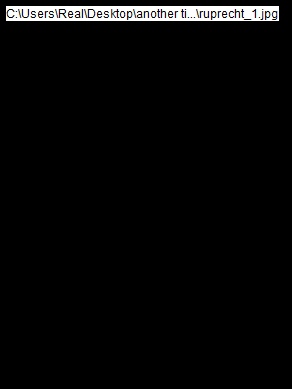
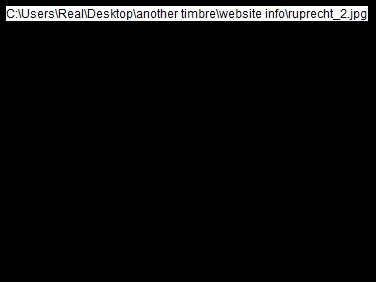
Discount price £5